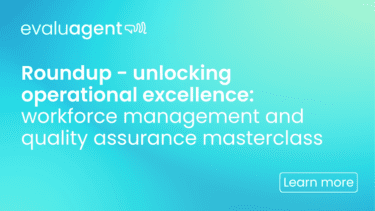Roundup: Unlocking operational excellence: Workforce Management and Quality Assurance masterclass


For our recent #webinarwednesday we were joined by Chris Dealy, WFM Evangelist at injixo, who has been in the contact centre WFM industry for over 20 years. Our Quality and Coaching Specialist, Chris Mounce, talked to Chris about unlocking operational excellence through combining workforce management (WFM) and quality assurance (QA) in your contact centre.
This blog post brings you a roundup of some* (there’s a lot!) of the key takeaways from the webinar.
*You can watch the full webinar here.
The business benefits of QA, with and without AI, depends on where you’re at in your journey:
As Chris Mounce explains “The benefits are relative to the stage you’re at in your journey. And the further you go the more benefits you unlock. Spreadsheets, for example, usually mean a lot of time is spent evaluating contacts and reporting on performance. As you move up the stages, you begin to unlock more and more. Take selecting an interaction to evaluate as an example, you could just be randomly clicking through your call recorder looking for a good one to evaluate, you might have to go through two or three each time before you find one that’s suitable. That time spent all adds up. Using a dedicated QA platform with automated workflows will take care of that for you as an evaluator, all you need to do is carry out the evaluation. The platform will take the strain of looking for that interaction.”
“Moving away from spreadsheets to Scorecards has the potential to increase productivity by 285%”
“If you’ve ever seen a scorecard on a spreadsheet, they look pretty complex and are difficult to complete. Scorecards on a QA platform are easier to understand and score. We’ve seen productivity increase by up 285% by using scorecards that have been created by our customers, using our technology and taking advantage of automated workflows. The great thing is the level of actionable insight you get from these more efficient processes is dramatically increased. It’s a win-win.”
The benefits of Auto-QA and AI are endless…
Increasing your conversation coverage from 5% to 100% with Auto-QA and AI means you will have:
“Ultimately a strong QA programme will save you time, minimise costs and improve performance.”
One thing that’s important to mention is that Auto-QA does not replace manual QA. The Auto-QA workflows fit neatly alongside the manual elements to create a much more efficient and effective process overall.
WFM is equally important… here’s why:
WFM is about having agents doing the right things at the right time and that includes, not just the customer facing activities, but also vitally important things like 1:1s and coaching sessions because without both, quality will suffer.
There are three opposing forces at play in every contact centre;
All these forces are pulling in different directions and what we need to do is try to satisfy them all and not optimise one at the expense of the others.
WFM is about finding the optimum balance, consistently aligning ‘vector’s’ that otherwise are acting against each other.
“During the pandemic and the great resignation, we had to quickly move our focus to employee experience. Now there’s evidence that CX is coming back to the forefront, and we need to be ready.” Chris Dealy
There are five essential components of WFM
Bringing together QA and WFM is where the magic happens:
“The performance improvement elements of a quality programme can be considered as one of those opposing forces – those that are coaches, it’s in our DNA to support the development of people and when you’re in that sweet spot during a coaching – that lightbulb switching on moment, you need to see that through. WFM tells you what you have to work with in terms of coaching time and also everything else that the agent has to do in the working day. You can have an appreciation for those other forces. We’re all working towards the same aim. We just need to be smarter in how we approach those sessions to get maximum value from them.” Chris Mounce.
There are lots of WFM applications on the market. Here’s what should you look for when buying a WFM system:
AI in QA is like having a co-pilot…
Scoring interactions can be boring, we’re human and even with the best will in the world, eventually you’ll get tired of it and just want it done. Using AI will give you risk based conversation to evaluate, it’ll also help you evaluate the conversations, give reasoning and improvement tips that you can use to enrich the conversations you have with your agents. You can put more focus on improving the agent rather than it all being on the data.
As a team leader or coach in a contact centre, where do you want to spend your time? Ticking boxes or having conversations that can make your agents be the best that they can be? This is where all those integrated workflows really come into play, seamlessly linking actionable insight with people improvement to make the best use of time.
If you’re keen to learn more, you can watch the full webinar here.